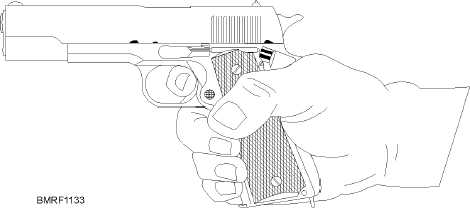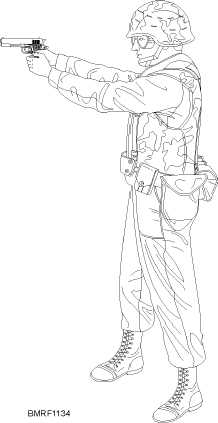As you read this paragraph, refer to figure 11-33.
Grip the receiver firmly with the hand and fingers. Wrap
the three lower fingers around the receiver (grip), and
place the trigger finger on the trigger between the tip and
second joint so that the trigger can be squeezed to the
rear. Hold your thumb up and along the side of the pistol
with enough pressure to steady the pistol and to equalize
any pressure from the other side by the palm and
forefinger. Once you have a firm grip, maintaining the
same degree of firmness throughout firing is important.
A change in your grip will change the location of the
shot group on the target. A tight grip tends to cause the
bullet to strike low and a loose grip to strike high.
With a proper grip on the pistol, the muscles of your
arm should be firm, but not rigid. Your arm should be
straight with your wrist and elbow locked. This will
prevent excessive up-and-down movement of the
weapon. When the weapon is fired, the recoil will be
absorbed through the arm to the shoulder. If you are in
the correct position, the pistol will return to
approximately the same sight picture after each shot.
STANDING POSITION TWO-HAND GRIP.—
In this position (fig. 11-34), you face the target squarely
with your feet placed comfortably about shoulder width
apart. Keep your legs straight without stiffness and your
hips level and slightly forward. Relax the muscles of
your diaphragm, and make no effort to hold in your
abdomen.
Grasp the pistol in the same manner as if you were
firing one-handed. Place the nonfiring hand under the
firing hand, wrapping the nonfiring fingers around the
back of the firing hand. Place the thumb over the middle
finger of the firing hand. Lock the weapon firmly in both
hands (fig. 11-35). Bring the weapon onto the center of
the target by shifting your feet.
MISCELLANEOUS.—In both the one-hand and
two-hand positions, position your head so that you are
11-22
Student Notes:
Figure 11-33.—Gripping the pistol (one hand).
Figure 11-34.—Standing position (pistol), two-handed grip.




